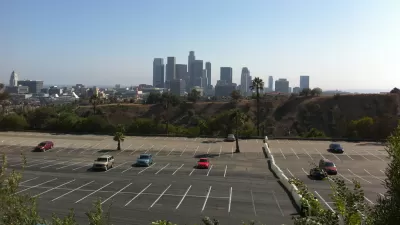An editorial in the Los Angeles Times praises the Cornfield Arroyo Seco Specific Plan as a model for how the city can break free of outdated zoning laws that force residents into obsolete living, working and commuting patterns.
After more than a decade of trying to "turn neglected neighborhoods and underused industrial properties next to the former Southern Pacific rail yard north of downtown — known as the Cornfield — into a collection of new urban zones," the Cornfield Arroyo Seco Specific Plan moved one step closer to passage this week with the approval of the City Council's planning committee.
As Los Angeles embarks on a long-overdue update to its 1946 zoning code, the Times points to the "smart land use model" and its four zoning types as worthy of emulating city-wide.
"There is a greenway zone, oriented toward enhancing the river as the neighborhood's frontyard. There is an urban village zone, focused on housing and other residential use, with some ground-floor retail. There is a denser urban center zone, close to rail stations, geared for job-creating uses but with residential space included. And there is an urban innovation zone, with flexible space geared toward anything from artists' studios to light manufacturing."
"The market has for years been demanding just those types of development in Los Angeles, and builders have been trying to respond — but have been getting stuck in variance hearings, lawsuits and community protests, development by development."
"The new zones and the new specific plan cut through that process. They bring that rarest of commodities to the Los Angeles land-use process: certainty."
FULL STORY: A model for L.A. planning

Alabama: Trump Terminates Settlements for Black Communities Harmed By Raw Sewage
Trump deemed the landmark civil rights agreement “illegal DEI and environmental justice policy.”

Planetizen Federal Action Tracker
A weekly monitor of how Trump’s orders and actions are impacting planners and planning in America.

Why Should We Subsidize Public Transportation?
Many public transit agencies face financial stress due to rising costs, declining fare revenue, and declining subsidies. Transit advocates must provide a strong business case for increasing public transit funding.

Understanding Road Diets
An explainer from Momentum highlights the advantages of reducing vehicle lanes in favor of more bike, transit, and pedestrian infrastructure.

New California Law Regulates Warehouse Pollution
A new law tightens building and emissions regulations for large distribution warehouses to mitigate air pollution and traffic in surrounding communities.

Phoenix Announces Opening Date for Light Rail Extension
The South Central extension will connect South Phoenix to downtown and other major hubs starting on June 7.
Urban Design for Planners 1: Software Tools
This six-course series explores essential urban design concepts using open source software and equips planners with the tools they need to participate fully in the urban design process.
Planning for Universal Design
Learn the tools for implementing Universal Design in planning regulations.
Caltrans
Smith Gee Studio
Institute for Housing and Urban Development Studies (IHS)
City of Grandview
Harvard GSD Executive Education
Toledo-Lucas County Plan Commissions
Salt Lake City
NYU Wagner Graduate School of Public Service



























